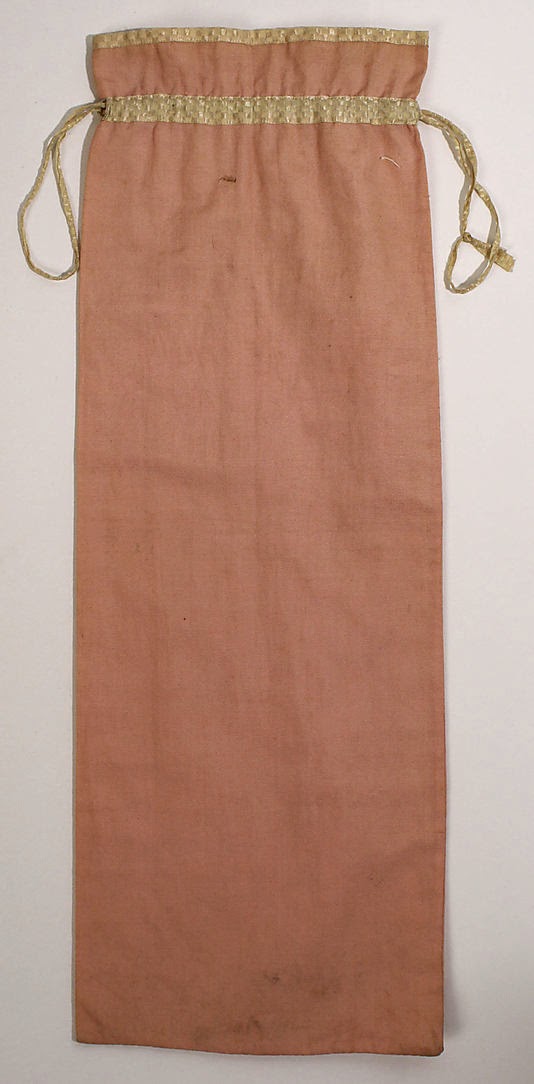Have a place for every thing,
and keep everything in its proper place.
Rev. Charles A Goodrich
1790-1862
Whether it's time or money spent, a corset is a major investment in an historical wardrobe. It was probably the same during the appropriate time and a lady would have taken care to keep her corset wearable for a long time. Four years ago I found this photo on auction for what was called a "corset bag".
What a practical idea! Of course a lady might have several corsets and she would want to keep them safe between wearings or have a place to carry them while traveling. Recently, while researching for a 1910s corset I discovered this article at The Metropolitan Museum of Art:
And what a discovery! Not only a beautiful corset....
...but a pretty matching bag!
For my corset bag I've used scraps left from making the pink/black polka dot underthings earlier this year and some small pieces of lace. The black/white polka dot ribbon is left over from the corset parasol I made and the small satin rose is the last from a hat I made. So all these little scraps get a new life!
I want my finished corset bag to be 7" wide and 19" long. I cut the pink/black cotton the length of the corset plus enough to turn the upper edge inside to create a channel for the ribbon tie. The width is double the width of the folded corset plus 1/2" seam allowances. Cut 2 of these pieces. One will be the outside of the corset bag, and one will be the inside. My pieces are 15" wide and 22" long.
The lower edge will also have a 1/2" seam allowance and the trim can be attached now so that the unfinished edges will be caught in the seam allowance or it can be added once the bag is complete. I added some additional lace and decided to attach the trim at the end of the project.
Allow 1/2" seam allowance for the top closure and then measure how far down you want the opening for your closing tie and place marks or pins so that you don't sew that area closed. Here I've marked the 1/2" seam allowance for the top, 1-1/2" for the portion of the corset bag which will be above the tie closure, and 3/4" for the tie opening. Now you can sew from the top to your tie opening, skip over the opening, and then sew from the opening down to the bottom.
Sew the second piece of fabric with a 1/2" seam allowance down the full length of the fabric. Press the seams open, and turn one tube right side out.
Place one tube inside the other so that the right sides are together, aligning the top edges and the long seam.
Sew the top closed with a 1/2" seam allowance.
Press the seam. Turn the tubes wrong sides together. Make sure the tie opening is on the outside of the bag. Sew a row of stitching above and one below the tie opening to create the tie casing.
Press the bag so that the long seam and tie opening are at the center back. Turn the bottom edges inside 1/2" with right sides together and stitch close to the bottom edge to close the bottom of the bag. Place your trim on the lower edge turning the raw edges under to create a nice finish and sew the trim to the bag just catching the bag in your trim and covering your bottom stitching.
Thread your ribbon (this is 33" of ribbon) through the casing and knot both ends together.
Add a pretty rose and your bag is finished!
Historical Sew Fortnightly
What It Is: Corset Bag
The Challenge: #13 Under $10
Fabric: Cotton
Pattern: None
Year: 1912
Notions: Ribbon, lace, satin rosebud, thread
How historically accurate is it? Verified by The Metropolitan Museum of art corset photo
Hours to complete? 30 minutes
First worn: Will hold a corset while traveling to Costume College.
Total Cost: All items left over from other projects but if purchased approximately $6.
Can you imagine the beautiful bags that could be made with embroidery, applique, and the assortment of leftover trims in our stash? I'll definitely be making more of these as Christmas gifts!
Love always,
Jeanette
.jpg)












































































